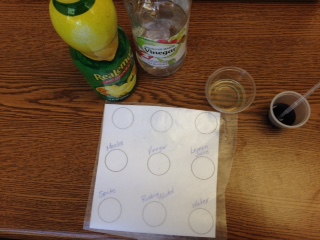So today, I want to share a lesson idea for science that is engaging, fun, light on resources, and can be integrated with other subjects. So here it is:
THE RAINBOW CHALLENGE
For this lesson, students will investigate acids and bases using a Cabbage Juice Indicator. It's super simple to make, but might be a little stinky. Check out the directions here.
Once you get it made, store in mason jars and put extra in your freezer. It lasts a long time! Students will be using the cabbage juice to test different substances to see if they are acids or bases. No fancy science equipment is required. Using wax paper with a paper guide placed underneath works great. You can also use a paint tray that has many small concave circles for this.
Next, you need some everyday items to test. It's always great to have a variety of liquids or solids that will show a variety of colors. Some suggested items: vinegar, lemon juice, Maalox, milk, sprite, baking soda, seltzer water, rubbing alcohol, or just about anything. Students will be mixing a small amount of Cabbage Juice Indicator with each of the liquids or solids. They are to take note of color change and compare it to the ph Chart. The ph chart for cabbage indicators is slightly different than the scientific chart. Here's some pictures for comparison:
As you can see from the above pictures, the Cabbage Juice Scale goes from 1 to 12, while the PH Scale goes from 1-14. The closer to 1, the more acidic. Around 7 is neutral, and 12/14 is very basic.
Use this free resource link to access student activity sheets and data collection papers. Discussion prompts and connections to other areas of the curriculum are included. Students LOVE this activity. It connects to chemical changes and also to the scientific process. End the lesson by making real world connections to acid rain. An integrated writing idea is included.
Have a great week, everyone! If you get a chance to do this activity, leave some feedback as to how it went.
Use this free resource link to access student activity sheets and data collection papers. Discussion prompts and connections to other areas of the curriculum are included. Students LOVE this activity. It connects to chemical changes and also to the scientific process. End the lesson by making real world connections to acid rain. An integrated writing idea is included.
Have a great week, everyone! If you get a chance to do this activity, leave some feedback as to how it went.



